The fashion style inherent to hippies is known to everyone; however, the history of its development and significance has often been overlooked. Hippies wanted their clothing to serve a broader purpose than just making them look good or keeping them warm. Vibrant colors, loose silhouettes, and cuts, the peace sign, and flowers will forever be associated with the multiculturalistic and naturalistic approach to life.
The nature of the hippie movement was characterized by a protest against the established capitalist rule in the US that had strict etiquette about wearing clothing. Hippies wore bright patterns to reflect their hectic but liberating lifestyle, which also promoted the use of recreational drugs. Because of this, the hippie cultural movement became extremely influential and grew in size to capture the attention of people from different societal layers.
Studying the fashion of the hippie culture is important because it illustrates the changes that society had undergone in the 1960s not only with regards to the style of clothing that people wore but also why they wore them and what message they wanted to communicate.
Review of Literature
Researchers that studied the hippie culture and fashion usually took two approaches that are quite different. While some focused on exploring the reasons for the fashion’s development, how it progressed, and what it meant, others preferred to analyze the style from the perspective of patterns, colors, and cuts. San Francisco was determined to be the city where hippies originated as it was demographically unique as well as scandalous compared to the rest of the cities on the US map.
Moretta (2017) explained that the hippie movement was difficult to define because “it included everyone, excluded no one” (p. 36). There was no unified opinion about what hippies wore; there were no requirements for gender, race, or age to participate in the movement. In its essence, hippies represented a “counterculture club” where everyone was free “to do their own thing” (Moretta, 2017, p. 36).
Garments that were immediately associated with the hippie culture included bright and unusual designs that some thought to be attention-seeking (Hill, 2016). Psychedelic patterns that mimic the landscapes of nature, flowers, animals, and other natural imagery were valuable parts of the fashion, as seen from the image (Figure 1) of George Harrison and Pattie Boyd (refer to Appendices).
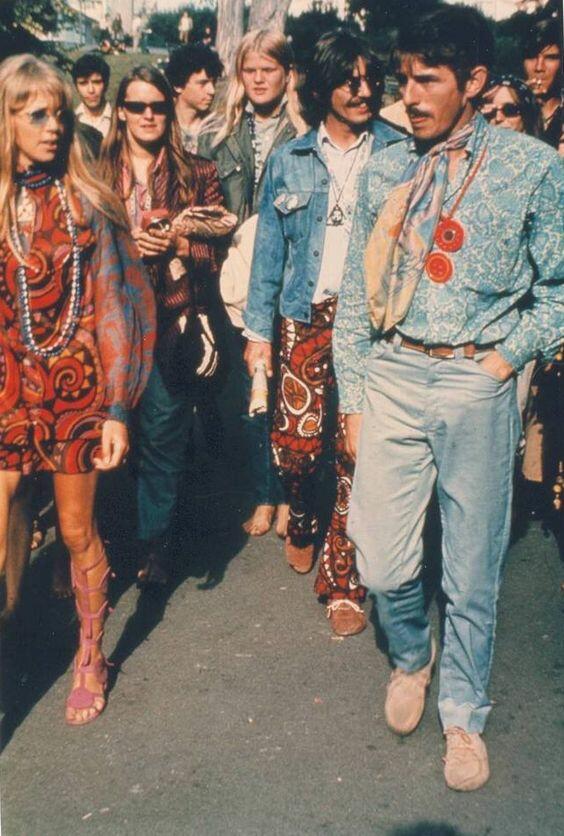
Shapes that hippies preferred in their clothing include bell bottoms, large and voluminous blouses, and dresses, and long flowy skirts and capes. Accessories often included multiple beads and flowers; headbands were especially popular both among men and women. Related trades in personal appearance complemented the entire style and free spirit of the hippie movement: men wore beards and long hair while women chose to stay away from bras and preferred their hair to grow out naturally (Figure 2). The philosophy behind such choices of appearance was associated with acknowledging the importance of free choices and rejecting the status quo. Even in the choice of materials for their clothing, hippies preferred natural fabrics such as cotton, linen, and wool.
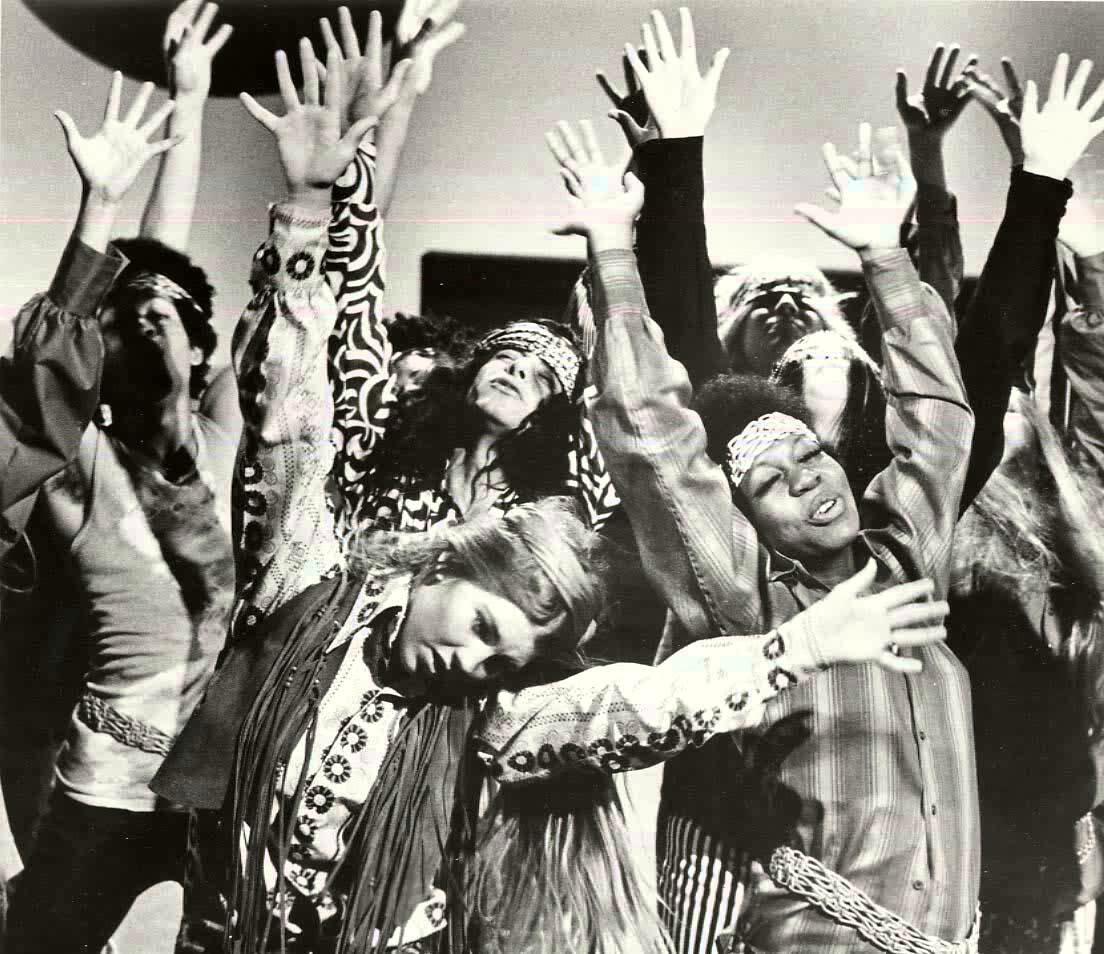
When discussing styles and patterns that hippies wore in the 1960s, the origins of the peace sign as an integral attribute of the culture’s vision should be discussed (Figure 3). Hippies were vocal about their anti-war opinions and participated in large protests to shed light on the armed conflicts in which the United States was involved (Cogswell, 2016).
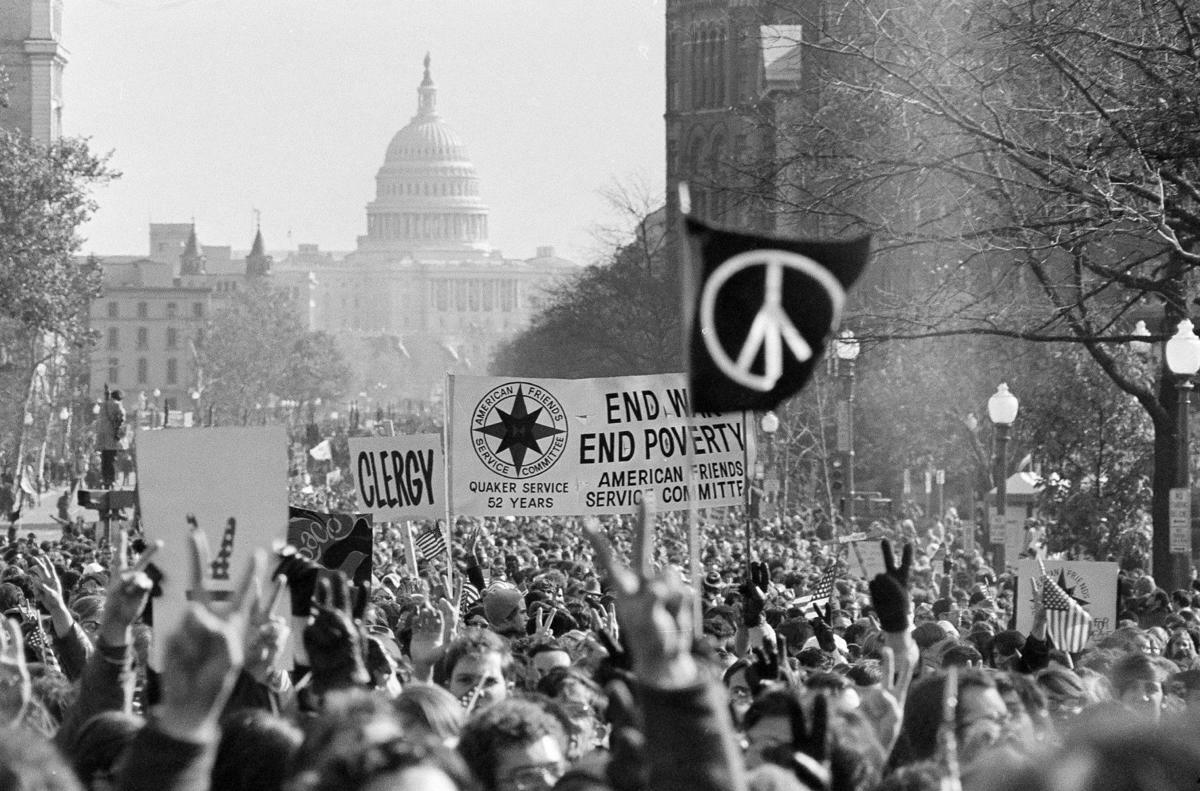
The Vietnam War was the central point of such protests, with hippies becoming famous for their influence in organizing pacifistic protests. The peace sign gained popularity during the protests as a symbol of love and service to humanity. It was designed by Gerald Helbert Holton, an artist, and a stanch peacemaker. Initially, the peace sign was intended to serve as a promotional symbol for the 1958 London march in support of the Campaign for Nuclear Disarmament (Klimke & Scharloth, 2008).
Later, the hippie movement started to use the sign extensively because it was not patented and restricted, but the message it sent was worth more than any other words. For aligning themselves with the anti-war movement outside protests, hippies wore brightly colored tie-dye t-shirts and dressed with prints of the peace signs. Other accessories such as medallion necklaces and headbands also showed the peace sign as an iconic attribute of the hippie culture.
Methods
Searching for primary or secondary sources on the topic of the hippie fashion of the 1960s was an easy task because the movement was extremely popular and, therefore, yielded much research regarding it. Hill’s (2016) San Francisco and the Long 60s and Moretta’s (2017) The Hippies: A 1960s History were particularly helpful for their broad analysis of the topic from the cultural, social, and political perspectives. Keywords’ search (including keywords: hippie movement, the hippie fashion of the ’60s, hippie culture, hippie imagery) was the main method of searching for relevant sources.
Once high-quality primary sources were found, the contents of each book were reviewed to find chapters that would be the most useful to the research. Secondary resources were also found through the Google search of keywords pertinent to the topic of hippie culture and fashion. The most credible and popular sources were selected; they usually appeared at the beginning of the search list, as they were the most viewed. These sources were evaluated for the presence of expert opinions of historians as well as the availability of visual materials that supported the discussion.
Results
The analysis of the 1960s’ hippie fashion showed that the choice of clothing, fabrics, accessories and other personal appearance components reflected the culture’s societal position rather than represented a particular taste or style. The key characteristic of the style was that people were free to wear whatever they liked and there were no specific guidelines that they had to follow. The free spirit and close connections to nature were mirrored in bright colors and flowy silhouettes of the hippie clothing style.
For outside spectators, the hippie fashion was somewhat confusing and often mysterious; as Hill (2016) cited, “long hairs and hippie clothing added to amplified music equal mystery and mystery coupled with youth are dangerous” (p. 216). However, there was nothing dangerous in what hippies as a “counterculture club” represented and wanted to achieve (Moretta, 2017, p. 36). The choices of colorful clothing were made to bring the attention of bystanders to joining the free-spirited movement and to uniting as a society that values love and peace over anything else.
The anti-war ideas that the hippie movement promoted were also reflected in the way they dressed. The role of the peace sign as a symbol of pacifism and a society free from armed conflicts was massive and is still relevant to this day. It is evident that through their choices of clothing, hippies wanted to challenge the established social norms and bring something new to the table. The analysis of their fashion showed that it was not important what hippies wore or what silhouettes were inherent to their style. Rather, it was important that the clothing brought unity to the movement and made it stand out from the rest (Herberg, 2015).
Nowadays, the hippie movement and fashion still exist while being tuned to the nature of modern society. Famous design houses such as Burberry (Figure 4), Saint Laurent, Anna Sui, Tory Burch, Etro (Figure 5), Emilio Pucci, and others have been inspired by the bright colors, floral patterns, and flowing silhouettes intrinsic to the hippie fashion of the 1960s.
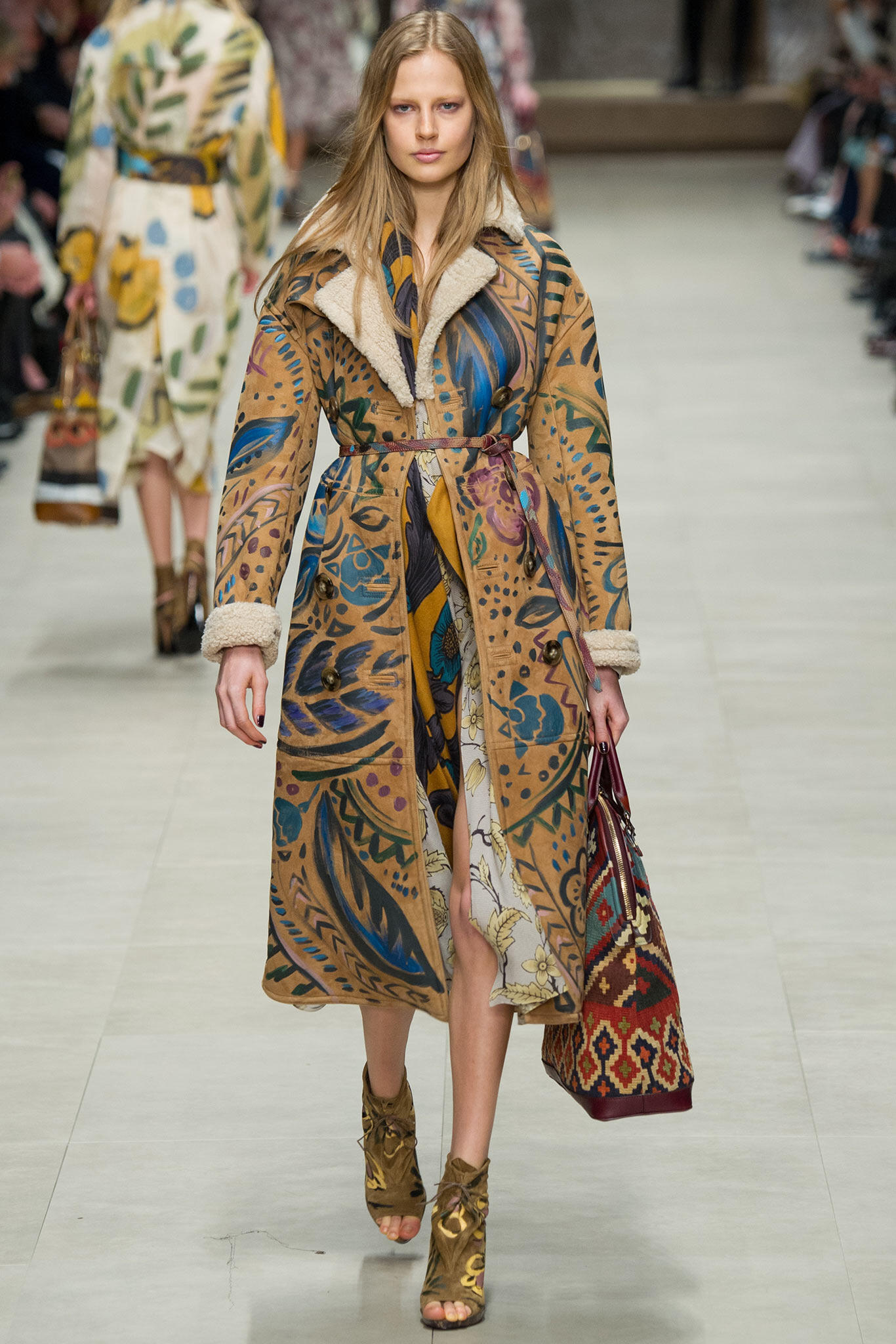
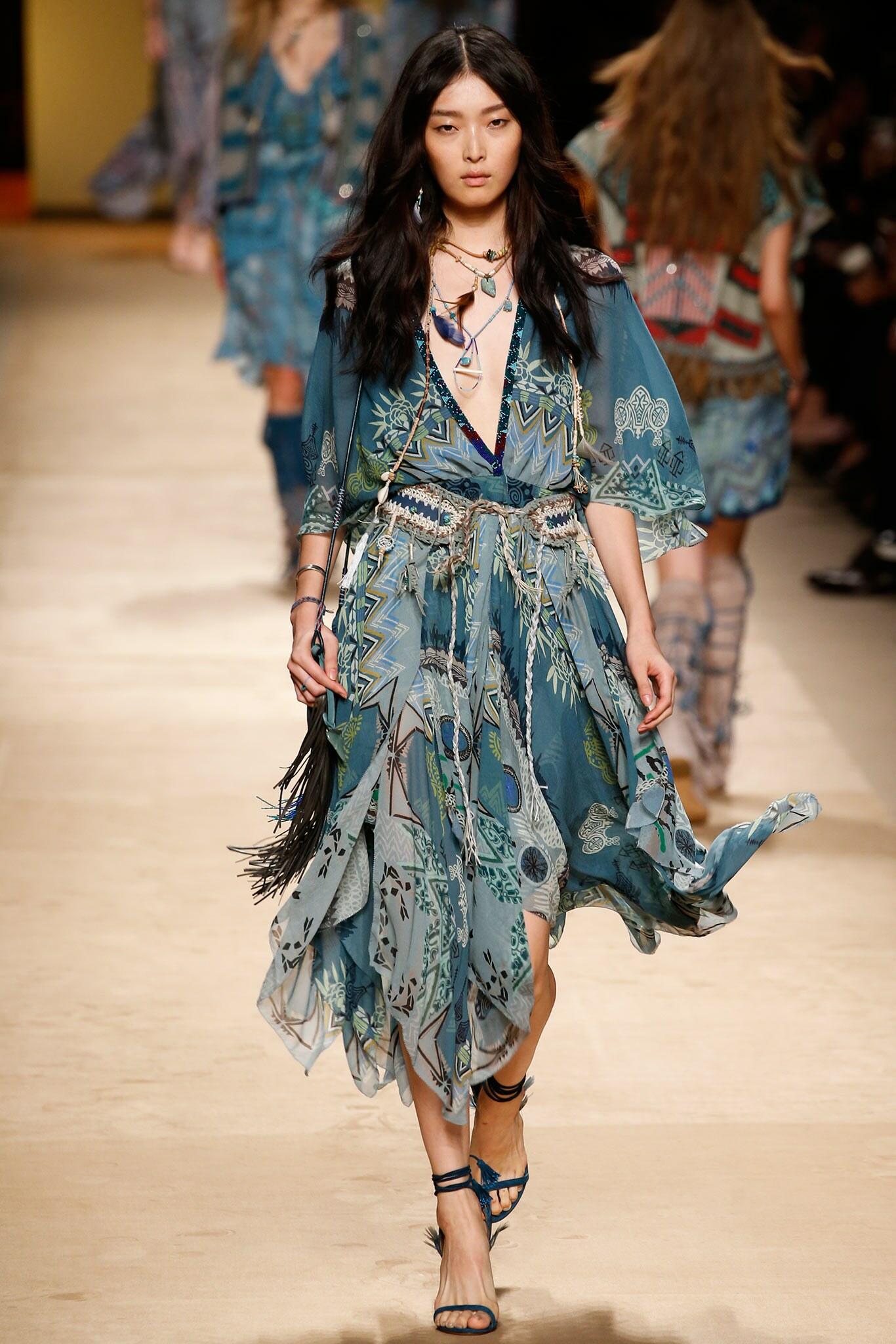
Conclusion
The cultural movement of hippies has never placed fashion in the center although its iconic styles and silhouettes played a significant role in the further development of fashion. Originating in the 1960s, hippies became an international collective of individuals that opposed the capitalist rule and heavily supported the anti-war narrative that the government of that time failed to address.
The fundamental ethos of hippies that was conveyed in harmony with nature, artistic experimentation, and the use of recreational drugs reflected the bold floral and psychedelic patterns of clothing, unrestricted cuts, and choices of natural fabrics such as linen, cotton, wool, and hemp. Thus, hippies represented a spirit and an essence of freedom rather than a particular clothing style; however, without even trying, they influenced the development of fashion and are still recognized as massive trendsetters that modern designers aspire to even today.
References
Anti-Vietnam War demonstrators march toward the White House [Image]. (1969). Web.
Cogswell, N. (2016). The history of the hippie cultural movement.The Culture Trip. Web.
Etro spring 2015 ready-to-wear[Image]. (2015). Web.
Herberg, W. (2015). Who are the hippies? National Review. Web.
Hill, S. (2016). San Francisco and the long 60s. New York, NY: Bloomsbury.
Klimke, M., & Scharloth, J. (2008). 1968 in Europe: A history of protest and activism, 1956-1977. New York, NY: Palgrave Macmillan.
Moretta, J. (2017). The hippies: A 1960s history. Jefferson, NC: McFarland & Company.
Pattie Boyd and George Harrison in San Francisco [Image]. (n.d.). Web.
Who are the hippies? [Image]. (2015). Web.